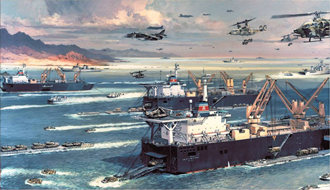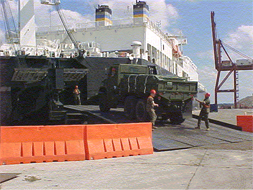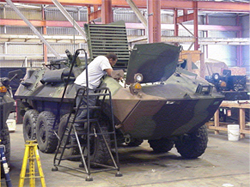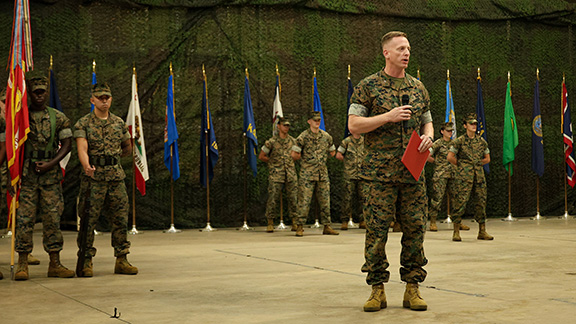
History
The concept of a Maritime Prepositioning Force was first envisioned during the late 1970’s. In 1977, President Jimmy Carter signed the directive that created the Rapid Deployment Joint Task Force.
Near Term Prepositioning Force, the initial program established in 1979, loaded existing operational force equipment and supplies on ships belonging to the U.S. Navy's Military Sealift Command. By 1980, the Marine Corps used seven Military Sealift Command chartered vessels that could carry supplies where needed. These dedicated ships were loaded in Wilmington, North Carolina, in July 1980 and became fully operational in 1981. While based in Diego Garcia, equipment and ship maintenance for them was conducted in Naha, Okinawa, and Subic Bay Naval Base in Philippines.
The Marine Corps immediately recognized the advantages of forward deployed prepositioning equipment during the critical early stages of crisis response. It seized the opportunity to revolutionize combat readiness.
In March 1983, the Commandant of the Marine Corps directed Marine Corps Logistic Base, Albany, to acquire the assets for the Maritime Prepositioning Force. Military Sealift Command leased thirteen ships for the force. The ships were formed into three Maritime Prepositioning Squadrons (MPSRONs). MPSRON-1 and -2 were loaded in Wilmington, North Carolina, and MPSRON-3 was loaded in Panama City, Florida. The ammunition for all three squadrons was loaded in Military Ocean Terminal at Sunny Point, North Carolina.
Operation Desert Shield and Desert Storm validated the Maritime Prepositioning Force concept when it supported the establishment of the first self-sustaining, operationally capable force in northern Saudi Arabia. The first battalion of the 7th Marine Expeditionary Brigade occupied its defensive positions within four days of the Maritime Prepositioning Force arrival. The first nine ships from MPSRON-2 and MPSRON-3 offloaded in August 1990 and provided equipment and 30 days sustainment for two-thirds of the Marine Corps forces ashore, as well as supporting U.S. Army forces. The ships of MPSRON-1 offloaded in December 1990.
In June 1991, Maritime Prepositioning Force assets were employed as part of Operation Fiery Vigil to assist the Republic of the Philippines when Mount Pinatubo erupted, burying whole cities and forcing the evacuation of Clark Air Base. Also, from December 1992 through May 1993, Maritime Prepositioning Force, reconstituted in Al Jubayl, supported Marines conducting peacekeeping and humanitarian assistance operations in Somalia during Operation Restore Hope. In January 2003, 11 of the then 15 Maritime Prepositioning Force ships were offloaded in support of Operation Iraqi Freedom and reconstituted between July and November 2003. In February 2004, selected equipment and supplies from MPSRON-2 were used in support of Operation Iraqi Freedom-II.
Success of a Marine Air Ground Task Force with the Maritime Prepositioning Ships Program is the availability and readiness of prepositioned equipment and supplies.
Property Leased, Purchased
 In 1986, the Marine Corps established the Biennial Maintenance Command at Blount Island in Jacksonville, Florida. The Marines leased 262 acres (1.06 sq km) from Gate Maritime Properties for $11 million per year. In 1989, Blount Island Command was established as a subordinate command to Marine Corps Logistics Command in Albany, Georgia.
In 1986, the Marine Corps established the Biennial Maintenance Command at Blount Island in Jacksonville, Florida. The Marines leased 262 acres (1.06 sq km) from Gate Maritime Properties for $11 million per year. In 1989, Blount Island Command was established as a subordinate command to Marine Corps Logistics Command in Albany, Georgia.
With the lease due to end in 2004, the Marines stated their intentions to purchase the property in 2000. The Marine Corps budget included $115.7 million for the acquisition, but extended negotiations did not result in an agreement. Gate Maritime Properties contended that the land was worth between $160 million and $200 million. In August 2004, the Marine Corps seized 1,100 acres (4.5 sq km) on Blount Island (the lessor's entire Blount Island holdings) by eminent domain and initially paid $101 million. When land is seized by eminent domain for uses that benefit the public, the government is required to pay landowners "just compensation." Gate Maritime Properties asked for a jury to decide the land's value. On Nov. 14, 2005, a jury determined that the government must pay $160 million for the parcel.
On Nov. 21, 2006, Marine Corps Support Facility Blount Island was officially activated as the host installation for Blount Island Command. The installation is a subordinate command of the Marine Corps Installations East, located at Camp Lejeune, North Carolina.
Global Readiness
 As the hub of the Marine Corps’ prepositioning programs, Marine Corps Support Facility Blount Island serves as the home of Blount Island Command and its worldwide mission supporting Marine expeditionary forces. Marines, Sailors, civilians and defense contractors are singularly dedicated to providing Marine warfighters with the best combat ready equipment and supplies in the world.
As the hub of the Marine Corps’ prepositioning programs, Marine Corps Support Facility Blount Island serves as the home of Blount Island Command and its worldwide mission supporting Marine expeditionary forces. Marines, Sailors, civilians and defense contractors are singularly dedicated to providing Marine warfighters with the best combat ready equipment and supplies in the world.
The workforce, roughly 250 military and civilian employees with 1,000 defense contractors, focuses on the combat readiness, visibility and attainment of prepositioned equipment and supplies, during contingency, humanitarian and disaster relief operations.
Approximately once every 42 months, the maritime prepositioning ships, operated by Military Sealift Command, must go into dry dock for inspection and maintenance. The Marine Corps uses this time to access the ships' equipment, which is then inspected, maintained and tested. Combat equipment is also repaired and painted as required. Where required, vehicle and equipment gets replaced, and modifications and upgrades get installed.
Since inception, the importance of prepositioning programs to the defense of our nation has been demonstrated numerous times. They were highlighted during contingency operations Desert Storm and Iraqi Freedom most visibly, as well as during nearly a dozen of other smaller scale contingencies and humanitarian and disaster relief operations.

When Blount Island Command celebrated its 38th birthday during a ceremony Sept. 4, 2024, Col. Luke Watson, commanding officer, announced its sixth Meritorious Unit Commendation. Between October 2020 to September 2022, the command supported four separate geographic combatant commands, including seven large scale exercises, and excelled in modernizing Marine Corps prepositioning programs with strategic level impacts, including 18 time-sensitive presidential directives.